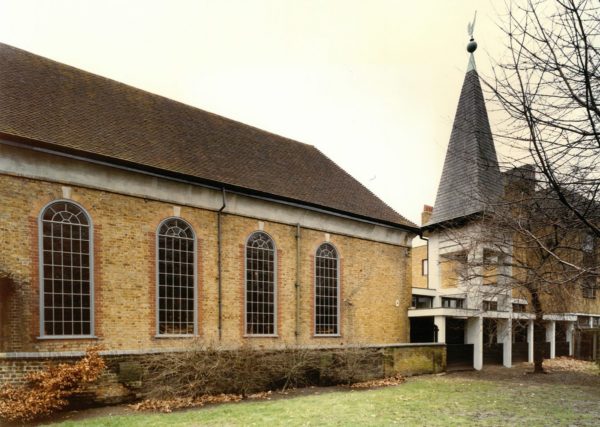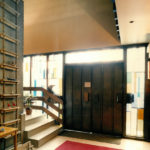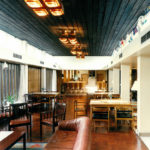GÄSTBLOGG – Svenska sjömankyrkan i London
Publicerat: 26 mar, 2015I dagens blogg har vi bjudit in och publicerar en text av Geraint Franklin, Historic England som skriver om Svenska sjömankyrkan i London. En kyrka ritad av arkitekt Bent Jörgen Jörgensen och som sedan i höstas är skyddad. Texten återges på engelska.
Swedish Seamen’s Mission, Rotherhithe, London
Historic England has recently listed a piece of Sweden?s heritage in Britain: the Swedish Seamen’s Mission in London?s docklands. It was built in 1964-66 to designs by Bent Jörgen Jörgensen (1915-1999), a Danish-educated architect who built up an successful practice in Växjö, Sweden. The completed building was opened by King Gustaf VI Adolf of Sweden on 6 November 1966.

The exteriors of the Swedish Mission are disarmingly simple, but inside unfolds a rich sequence of contrasting spaces: double-height entrance hall, intimate servery, aisled hall, and culminating in the mission church. Jörgensen retained and reordered Wigglesworth and Marshall Mackenzie?s 1930 church, stripping back its interior to a brick box and adding a blue-beamed ceiling and bespoke copper light fittings. The assured handling of daylight and natural materials is quintessentially Scandinavian, with daylight filtered through opaque glass in some places and modulated by deep mullions in others. Many of the fittings, such as Jörgensen?s light fittings and a coloured glass wall by Christer Sjögren (1926-2008) of the Lindshammar Glasbruk were shipped direct from Sweden. As a whole, the building is a storehouse of good Swedish craft and design, at a time ? then as now ? when it was widely admired and imported to Britain.
Seamen’s missions represented a ?home from home? for mariners, combining places of worship with social and welfare facilities. The Swedish Seamen?s Mission is one of a trio of Grade II-listed Scandinavian missions which served the Surrey Commercial Docks in London?s Docklands, long the principal point of entry for Scandinavian timber. Norway is represented by St Olav?s Kirke (1927, John L. Seaton Dahl) and the Finnish Seamen?s Mission of 1957-59 was designed by the Finnish-born Cyril Sjöström Mardall of Yorke Rosenberg and Mardal (YRM). Not too far away, on Commercial Road, is the former Danish Seamen?s Mission of 1958-59, designed by Holger Jensen.
Britt-Marie Börjesgård of the Jönköpings läns museum provided us with valuable information about the architect. Jörgensen trained at the Art Academy in Copenhagen where he met and was influenced by Erik Gunnar Asplund, Alvar Aalto and Steen Eiler Rasmussen. He started his career in the offices of Hans Westman in Skåne, Sweden (1938-40 and 1945-47) and Arne Jacobsen in Copenhagen (1942-45). Jörgensen supervised the practice after Jacobsen went into exile in Sweden in 1943. In 1947 he took over Paul Boberg?s practice in Växjö after Boberg?s death, and over the next three decades realised a variety of projects, including a hotel in Värnamo (1952-55), Vetlanda City Hall (1962-70), Swedish Emigrant Institute in Vaxjo (1967) and churches of various denominations.
Historic England is a government service championing England’s heritage and giving expert, constructive advice. It is the Government?s statutory adviser on the designation of heritage assets in England, such as listed buildings. In England there are approximately 376,099 listed building entries at the time of writing; they can be viewed on the National Heritage List for England (NHLE). The Swedish Seamen’s Mission is listed at Grade II. Grade II buildings are nationally important and of special interest, and 92% of England?s listed buildings fall into this class.
But listing is only the start of the process of managing our historic environment. In May 2011 the Committee for the Church of Sweden Abroad announced its decision to close the Mission and concentrate their activities at the Swedish Church at Harcourt Street. However the building is reused, it is to be hoped that its distinctive character and appearance is preserved or enhanced for the enjoyment of future generations.
Geraint Franklin, Historic England
Photo caption: the church of the Swedish Seamen’s Mission, photographed in 1995. Photo © Historic England
- Kyrksalen.
- Entréhallen, notera repstegen som utgör hylla.
- Cafeterian.
- Samlingsrummet.
- Samlingsrummet.





